Colored belts have their origin in Judo, as does the training ‘gi’, or more correctly in Japanese, ‘dōgi‘ or ‘Keikogi’. In Kyokushin the order of the belts varies in some breakaway groups, for example replacing orange with red, but they follow the kyu ranks for the most part.
Contrary to popular belief, using colored belts to denote rank or ability in martial arts hasn’t been around that long, being introduced around the turn of the 20th century.

The modern karate and Judo uniform was introduced by the founder of judo, Kanō Jigorō, who first took up jujutsu in an effort to gain strength. A well-regarded teacher and polymath in his home country of Japan, Jigorō created judo from his study of jujutsu in the late 1800s.
Shortly after creating judo in the 1880s, Jigorō began awarding some of his students the rank of Shodan, literally “beginning degree,” which is the lowest black belt rank, first bestowing this rank on Tomita Tsunejirō and Saigō Shirō.
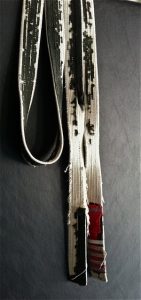 There are many romanticized ideas of how the belt colors in the martial arts came to be. For example the story which states that students of a karate would be given a white belt that gradually become stained darker from use, eventually going to brown, black and back to white again. While this makes for a wonderful story, it is nothing more than that, just a story.
There are many romanticized ideas of how the belt colors in the martial arts came to be. For example the story which states that students of a karate would be given a white belt that gradually become stained darker from use, eventually going to brown, black and back to white again. While this makes for a wonderful story, it is nothing more than that, just a story.
In fact, in the early days of judo, the students did not wear the gi we associate with many forms of martial arts today. Rather, judo was practiced wearing a traditional full length kimono secured with a regular belt (obi).
In 1907, Jigorō introduced the modern uniform and its thinner obi. The colors consisted of white and black. White for the less experienced (mudansha) and black for the more experienced yudansha. White denoted simplicity and purity, and the white belt of the beginner showed that the student began empty, but eventually was filled with knowledge.
This ranking system was inspired by the existing Dan ranking system in the 5,500 year old boardgame Go. Prior to this, more experienced students in various forms of martial arts in Japan tended to be given scrolls indicating their abilities and teaching license.
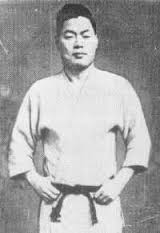
Judo teacher Mikonosuke Kawaishi, who was teaching in Paris, is credited with incorporating other colors into the uniform around 1935, as a way to motivate his students toward even greater achievement. This was also adapted into Karate by Gichin Funakoshi, the founder of Shotokan, in an attempt to increase Okinawan Karate’s appeal to the Japanese people.
Belts In Kyokushin Karate
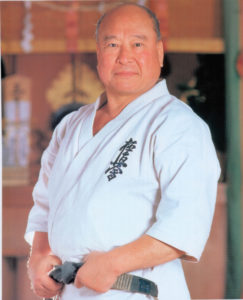
The belt system in Kyokushin was introduced by it’s founder, Masutatsu ‘Mas’ Oyama, who was a former student of Shotokan, under Gichin Funakoshi, in which he obtained the rank of 4th dan black. Not to mention also having the ranks of 7th Dan Black Belt in Gōjū-ryū Karate and 4th Dan Black Belt in Judo.
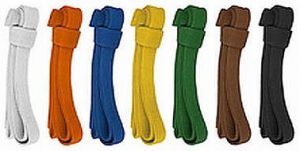 The belt system is divided into 10 Kyu grades (beginner grades) and Dan grades (advanced grades) up to 10.
The belt system is divided into 10 Kyu grades (beginner grades) and Dan grades (advanced grades) up to 10.
Each colored belt has two levels, the second being represented by a stripe at the end of the belt. The white (Mukyu) belt however, does not represent any level and of the white belt literally means no grade. As such, the white belt is used by practitioners who are not yet graded. The belt system under Mas Oyama followed this order since the 1960s with the exception of the red belt, which was incorporated only in the last year of his life, replacing the earlier used white belt with one and two red stripes for the same kyu grades.
While some groups also use red belts for high dan grades, Sosai Mas Oyama did not follow this practice in his dojo or organization, always wearing a wholly black belt for himself.
The belt path in 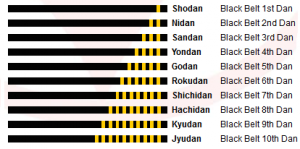 Kyokushin is not a short one. One would expect to train twice to three times a week for at least 5 years before achieving the rank of 1st Dan, or Black Belt. 1st Dan is considered the beginning, with Dan grades going up to 10th Dan, with the 10th usually reserved for the founder of the system, or the head of an organization. Comparing the ranks to the Western schooling system, think of the colored belts = grade school, 1st Dan through 4th Dan = undergrad, 5thDan = Masters, and anything above = a phd.
Kyokushin is not a short one. One would expect to train twice to three times a week for at least 5 years before achieving the rank of 1st Dan, or Black Belt. 1st Dan is considered the beginning, with Dan grades going up to 10th Dan, with the 10th usually reserved for the founder of the system, or the head of an organization. Comparing the ranks to the Western schooling system, think of the colored belts = grade school, 1st Dan through 4th Dan = undergrad, 5thDan = Masters, and anything above = a phd.
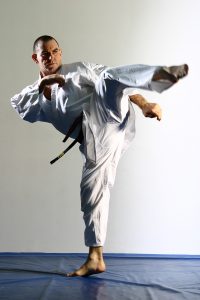
Perhaps the most widely read and respected interpretation of the fundamental psychological requirements of each level of belt is found in the book, The Budo Karate of Mas Oyama, written by former student and interpreter to Sosai Masutatsu Oyama, Cameron Quinn.
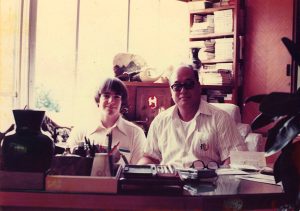
The entry bellow is an excerpt from this book:
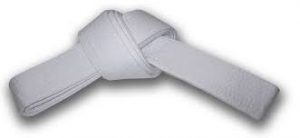 White belt
White belt
Level of purity and potential
Being new, unaware of the requirements of Kyokushin Karate and lacking in experience of it, the white belt’s heart is said to be full of hope. From this hope sprouts the first enthusiasm to train and learn.
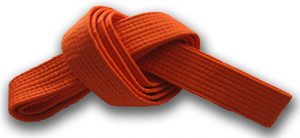 Orange Belt
Orange Belt
Level of stability
Progressing from white belt comes the orange belt (replaced by red in some organizations). The first colour after purity level which is associated to earth (soil) colour. The major focus at this level is understanding the physical base.
Power and progress are built upon a solid foundation. Fundamentals such as your stances (eg. sanchin dachi) are very much reinforced and expected to be perfected.
At this stage, a lifestyle and vision of ambition, gratitude, persistence and vitality should be adopted. Every student must establish a commitment to attending classes. There can be an internal battle for each individual in overcoming self-defeating stubbornness that resists the desire to attend lessons. It is your battle to win. Orange belts should be enthusiastic in training, treasures dreams of greater things to come.
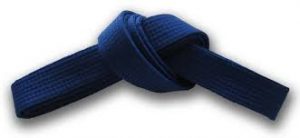 Blue Belt
Blue Belt
Level of fluidity, adaptability
Blue, the symbolism for colour of water.
Blue belt at this level develops a basic ability to adapt and react fluidity. Just as water adapts to the shape of whichever object is holding it. Adaptability grows through kumite (sparring).
Independence begins to establish itself, the student learns to adapt karate to best suit his physical strengths and weaknesses. Development for a strong body, especially in the torso and arms takes place. Special attention is paid to training push-ups using the forefists and finger tips.
In terms of flexibility (physical and mental), students at this level should do relatively well in stretching (which can be achieved through regular stretching).
Enthusiasm wanes sometimes to the point of despair, with desire to give up. Remember these are part and parcel of training; being able to recognise stumbling blocks in your journey of learning and appropriately dealing with them successfully is essential.
Stay calm in the midst of a raging battle (be it during kumite or your internal battle), the spirit and mind of a true Kyokushin Karate student shall remain unshaken.
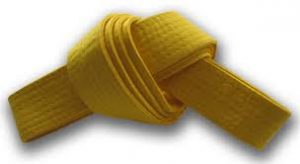 Yellow Belt
Yellow Belt
Level of assertion
Apart from concentrating purely on physical skills (such as balance, stability, eye/hand co-ordination, and general technical ability) as compared to previous belts, Yellow belt also requires serious consideration to the psychological aspects of training- perception, awareness, assertion, and other manifestation of will-power. Students are expected to apply his/her intellect and awareness in co-ordinating the basic physical concepts of karate with his/her own mind’s immense potential.
Be confident in your growing abilities and be decisive in your every actions. Do your best to refine your karate knowledge and learn to perform all the movements in a pure and correct way.
Fears are overcome by confronting them confidently.
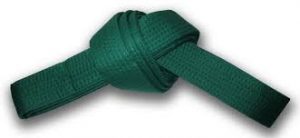 Green Belt
Green Belt
Emotion/Sensitivity Level
Green is first level of the senior colours.
The green belt is now more aware of his unique discriminating intelligence and the importance of benevolence and compassion. He would realize that power without wisdom and compassion is destructive, dangerous and callous. Just as Sosai states: strength without justice is violence; justice without strength is impotence.
The green belt would, by now have excellence in all his basic techniques, basic movement patterns, and be able to deliver all required kata. He learns to combine his technique with speed and strength that has been developed through hard training.
At this level, all green belts should work on the power aspect of karate. Kyokushin is power karate. The green belt should be able to demonstrate this power.
Sensitivity and timing- one must learn to feel the opponent’s intentions and balance, and how to time the use of techniques for maximum effect. You should also look into advanced technical concepts and methods; finds personal likes which you will begin to adopt into your own karate.
Remember, actions are reflexes, not premeditated moves. A technique happens naturally, without thought.
The green belt should have glimpses of the state of mind known as zanshin, where the body acts perfectly without conscious effort.
Every green belt should strive to develop a mature and fearless attitude in kumite, while mastering a deceptively calm and unassuming approach to self defence and daily life.
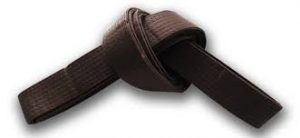 Brown belt
Brown belt
Practical / creative level
This is a very important level in training, which should be undertaken in serious, responsible and mature frame of mind.
By now, the brown belt should be very strong and very comfortable in the execution of all techniques, whilst continuing to strive to achieve ever higher levels of skill.
In sparring, the ability to control a junior opponent through timing, distance control and sensitivity, should be highly developed.
Junior students tend to feel that they can trust the brown belt and the brown belt should respect that trust through honesty, integrity, and loyalty.
You must constantly take a step back and look at yourself, make sure you are in control of the personality and the contents and prejudices of the mind; & not vice versa.
Every brown belt must brace himself with a brave heart and a will of iron, have faith in the beauty of the unknown that lies ahead.
Improvements in own technique are gained through participation in tournaments. Through that, one can then truly see if one’s training has been effective.
All too often, the brown belt becomes complacent at brown belt, satisfied with being at the top of the junior grades.
Be aware of this and learn to overcome through continuous hard training and moving on to the next belt level.
Do not stop your Kyokushin Karate training path here.
“Bathed in sweat, devoted entirely to what what I am doing, in training sessions I transcend both life and death.” – Mas Oyama.
The entry above is an excerpt from the book-
The Budo Karate of Mas Oyama, written by Cameron Quinn.
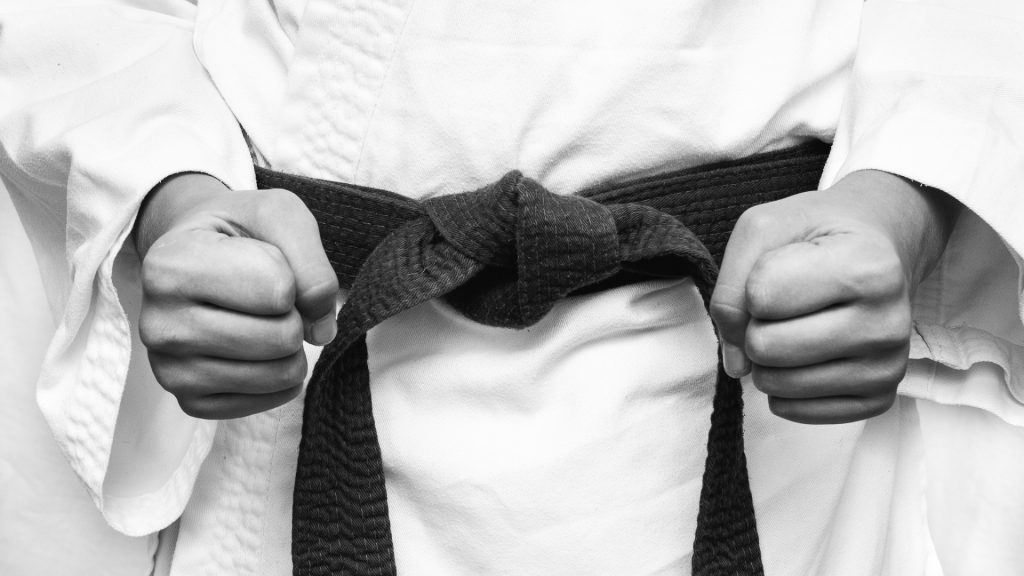
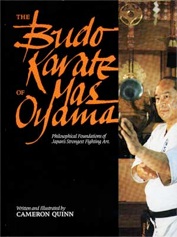
I am appreciative; your updates and write-ups have been really beneficial in helping me better grasp Kyokushin and in writing my school proposal.
Many thanks.
OSU.
I beg to differ on the colours of the belts. I think it’s a bit disingenuous to quote Cameron’s book and using orange as the first colour above white. It smacks a bit of rewriting history. I have before me the 1987 edition of Cameron Quinn’s book wherein the chapter on the first belt above white EXPLICITLY states RED BELT. To be fair, he mentions that some in Japan don’t use red – but go straight to blue – i.e. still using the 8 kyu system that I remember using the first couple of times I started training back in… Read more »
There is evidence to suggest that J.Kano was influenced by the use of colour when recognising proficiency within swimming through his work with the Olympic committee. This was brought into the Judo ranking system. Osu
I grateful, your write ups and updates, has been very helpful, it has helped me increase my understanding of Kyokushin more also helps me my school proposal write up,.
Thanks so much.
OSU.
[…] History of Belts In Kyokushin Karate The Martial Way […]
The system that of Mas. Oyama was in the 1960’s for 6th Dan white/red belt.
The first not Japanese who had his 6th Dan at the age around 35 years was wearing a Red/white belt at that time.
I guess it was in the 1990’s that it changed into a black belt with stripes on it.
Hi, Scott.
Great text.
I trained kyokushin in Brazil in 1982/1985 and there was no orange belt.
In other countries has there ever been the orange belt or was it introduced later like here in Brazil?
Would you know if it was Mas.Oyama who introduced the orange belt, or was it after his death?
thank you
No
if you have a chance to meet, listen and learn with Cameron Quinn Shihan, grab quickly this opportunity
Shihan is, no contest, one of best teacher a see.
Michaël Sempai
Osu !
very good thank you,I have trained Karate,and my grade is Shodan Ho, we were always led to believe that you should never wash your belt as your spirit lives in your belt.
Hi there. Great article. Didn’t Kyokushin originally have this system: yellow, orange, green, blue, brown then black? This would have changed about 20 years ago?
Thank you, Sensei Soesilo. I am a humble student of kyokushin. OSU!!
Great article…Osu
‘Richard Soesilo
Kyokushin SanDan
Now THIS is a great article ! Nothing like a History lesson.
Osu !
Peter G.N. GRIFFIN.
Sempai IKO3